Neurotransmitter imbalances are often at the root of many seemingly complex and distinct disorders, including depression, anxiety, migraines, insomnia, fibromyalgia, restless leg syndrome and even Parkinson’s disease. Neurotransmitter imbalances are not a simple case of ‘not having enough’; rather, it is a case of balance, and that balance can get thrown off by two very different processes, which require very different approaches to correct.
What is a Neurotransmitter Imbalance?
Neurotransmitter imbalances occur anytime the body’s neurotransmitter systems are not in balance. The body has dozens of neurotransmitters, but as far as anyone can tell, they seem to work in opposing systems, with an inhibitory neurotransmitter (or group of neurotransmitters) opposing a specific excitatory neurotransmitter (or group of neurotransmitters). Due to the work of Marty Hinz, MD and others, it is now known that imbalances in the serotonin-catecholamine system (catecholamines include the neurotransmitters dopamine, norepinephrine and epinephrine) are responsible for many of the symptoms associated with numerous disorders, including those listed above.
What this means is that the levels of serotonin and the catecholamines do not sufficiently balance one another, which causes symptoms. This balance is controlled by a transporter called the “organic cation transporter type 2” or “OCT2”. So when we use amino acid therapy to try and correct neurotransmitter imbalances, what we are really doing is trying to optimize the function of these OCT2 transporters in order to restore proper function.
What are the Causes of Neurotransmitter Imbalances?
There are two distinct causes of neurotransmitter imbalance: relative nutritional deficiency and neurotoxicity. Both cause neurotransmitter imbalance, but the manner in which they are corrected is very different. A relative nutritional deficiency occurs when the amount of amino acids obtained through the diet is not sufficient to provide the body the building blocks it needs to maintain (or obtain) optimized neurotransmitter function. A relative nutritional deficiency can be due to any number of variables, including stress, genetics and nutritional deficiency; it can also be due to such things as chronic pain and the use of certain medications. Whatever the reason, the result is that the body does not have the right mix of amino acids and/or cofactors necessary to properly synthesize sufficient neurotransmitter to optimize function, and symptoms develop. In essence, a person’s neurotransmitter stores are depleted/deficient and diet alone is not sufficient to replenish those stores, In this case, amino acid therapy provides the only known way to replenish a person’s stores of amino acids. Once those stores have been replenished, that person will be able to substantially reduce, and likely eliminate the need for ongoing amino acid therapy, using diet and lifestyle to maintain optimal neurotransmitter function instead.
On the other hand, neurotransmitter imbalance caused by neurotoxicity is permanent. Neurotoxicity is often caused by a blow to the head or neck or toxin exposure (including many medications, such as amphetamines). As the name implies, neurotoxicity means that neurons have been destroyed; this is a permanent state. However, in many cases, the symptoms due to neurotoxicity can be overcome with the correct balance of amino acids.This involves supplying the remaining viable neurons with sufficient amino acids so they can synthesize enough neurotransmitter to overcome the effects of neurotoxicity. This is what is occurring when we help a person with Parkinson’s disease become asymptomatic when they take the right balance of amino acids; we are supplying them the nutrients they need to overcome neurotoxicity. However, in the case of neurotoxicity, a person will need to remain on amino acids for the rest of their lives, as neurotoxicity is not known to be correctable.

